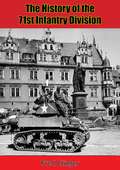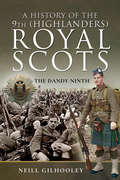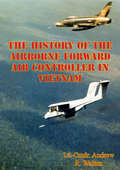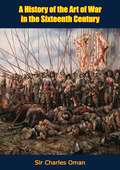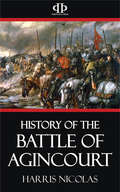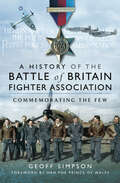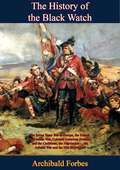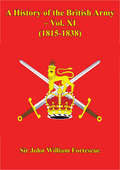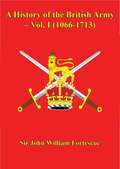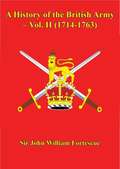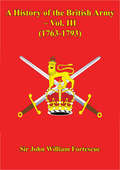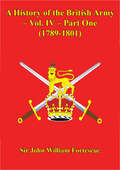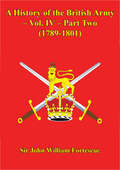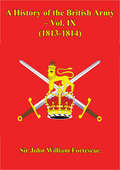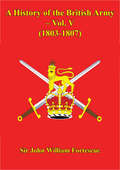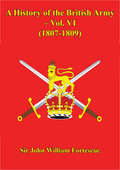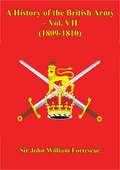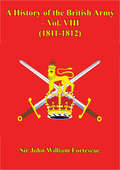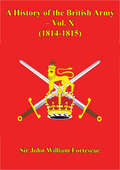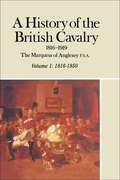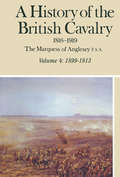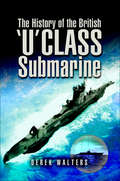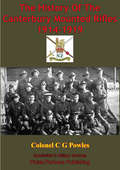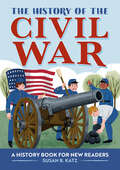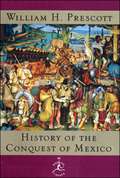- Table View
- List View
The History of the 71st Infantry Division
by Fred ClingerFirst published in 1946, this is an account of 71st Infantry Division’s role in World War II, it was activated on July 15, 1943 at Camp Carson, Colorado. After some time training in the U.S. the division arrived in France in February 1945, entering the line at Ratswiller on 11th March 1945. Thereafter the 71st pushed the German forces back all the way back to the Siegfried Line, capturing Pirmasens 21st March and capturing Bayreuth after bitter opposition on 16th April. The Division had the distinction of having advanced the furthest east of all the U.S. Army units, by which time it had fought numerous bloody engagements and being involved in the liberation of a sub-concentration camp at Gunskirschen.
A History of the 9th: The Dandy Ninth (Pals Ser.)
by Neill GilhooleyThis regimental history chronicles the Dandy Ninth Battalion Royal Scots from its first forays in the Boer War through the brutal fighting of WWI.After suffering the disastrous Black Week of the Second Boer War, the British Army formed a new Highland battalion, the kilted 9th Royal Scots, which became affectionately known as the Dandy Ninth. It sent volunteers to South Africa and established itself as Edinburgh’s kilted battalion, part of the Territorial Force of part-time soldiers.Mobilized in 1914 as part of the Lothian Brigade, the Dandy Ninth defended Edinburgh from the threat of invasion, and constructed part of the landward defenses around Liberton Tower. They were part-time soldiers and new recruits, drawn from the breadth of society, from lawyers to rugby players and artists, such as the Scottish Colorist F.C.B. Cadell, and William Geissler of the Edinburgh School.In the Great War they mobilized to France and Flanders and served in many of the major actions: in Ypres and on the Somme; at Arras and Cambrai in 1917; and during the 1918 German Spring Offensive at St Quentin. In the Advance to Victory, they were with the 15th (Scottish) Division.
The History Of The Airborne Forward Air Controller In Vietnam
by Lt.-Cmdr. Andrew R. WaltonThe U.S. Department of Defense predicts that ground forces of the future will wage tomorrow's wars by replacing large numbers of personnel and organic firepower for advanced technology and superior maneuverability. Those forces must be prepared to face an unconventional enemy who will operate in small, lethal units interspersed with the civilian population rather than facing coalition forces with massed formations. This scenario of blurred lines of battle and difficulty determining friend from foe resembles very closely what the U.S. military faced in Vietnam.This paper will address the successes and failures of United States airborne forward air controllers (FACs), particularly in Vietnam, and whether combat lessons learned were passed from service to service or historically from conflict to conflict. The FAC mission has not significantly changed since the end of the Vietnam War, and a thorough study of operational and tactical lessons learned by those aircrew will significantly enhance today's FACs ability to find and destroy dispersed enemy forces in a wide array of environments.
A History of the Art of War in the Sixteenth Century: A History Of The Art Of War In The Sixteenth Century (1937) (Routledge Revivals)
by Charles OmanTHE BEST ACCOUNT OF SIXTEENTH-CENTURY WARFARE BY THE AUTHOR OF A HISTORY OF THE PENINSULAR WARThis is an unrivalled account of sixteenth-century warfare, in which Sir Charles Oman traces the dramatic, far-reaching changes in the military strategy, tactics and organization of the period.Showing how warfare developed, he covers the Great Wars of 1949-1559; military events in Tudor England, including Henry VIII’s continental wars; the French Wars of Religion, 1562-98; the Dutch revolt and war of independence, 1568-1603; and the Turkish offensive against Christendom, from 1520 until the Peace of Sitva Torok in 1606.The battles, sieges and campaigns that Oman examines in detail clarify military development across the century, such as Ravenna (1512), the first battle won by dominance in artillery; Pavia (1525), a ‘victory by surprise’; Pinkie (1547), where an old-fashioned infantry army proved helpless against the combination of all arms; and Arques (1589), exemplifying the defence of a defile by very inferior number.Contemporary maps illustrate many of the actions, and add to the value of this brilliant and lucid history of the art of war.Sir Charles Oman was one of Britain’s foremost historians and a gifted writer. His books, noted for being both scholarly and accessible, include the two-volume History of the Art of War in the Middle Ages, the seven-volume A History of the Peninsular War and others.
History of the Battle of Agincourt
by Harris NicolasAbout the middle of the year 1414, Henry the Fifth, influenced by the persuasions of Chicheley, Archbishop of Canterbury, by the dying injunction of his royal father not to allow the kingdom to remain long at peace, or, more probably, by those feelings of ambition which were no less natural to his youth and personal character, than consonant with the manners of the times in which he lived, resolved to assert that claim to the crown of France, which his great-grandfather, Edward the Third, urged with such confidence and success...
A History of the Battle of Britain Fighter Association: Commemorating the Few (Battle of Britain)
by Geoff SimpsonIn 1945 it was announced that Allied airmen who had taken part in the Battle of Britain in 1940 would be entitled to the immediate award of the 1939-1945 Star, with Battle of Britain Clasp. This was the only Clasp awarded with the 1939-1945 Star.In the following years holders of the Clasp held informal get-togethers. In 1958 the Battle of Britain Fighter Association (BBFA) was formed, with full membership only available to holders of the Battle of Britain Clasp. Lord Dowding was the first President. Her Majesty Queen Elizabeth the Queen Mother became Patron. That post is now held by HRH The Prince of Wales.As well as organising reunions and providing some welfare assistance to members and widows, the Association has played a key role in researching entitlement to the Clasp and pronouncing on claims for the Clasp. A considerable part of the knowledge existing today on these matters came from the work of successive BBFA archivists, the late Group Captain Tom Gleave and the late Wing Commander John Young.The Association has also become closely associated with the Battle of Britain thanksgiving service held every September in Westminster Abbey.The Association's archives are held in part by the Secretary of the BBFA, Group Captain Patrick Tootal and in part by the Air Historical Branch, RAF (AHB) at RAF Northolt.Geoff Simpson has now been invited by the Association to use these archives as the basis of a book on the history of the organisation.
The History of the Black Watch: and the Caribbean, the Napoleonic ... the Ashanti War and the Nile Expedition
by Archibald Forbes“The first 150 years of one of the British Army's most renowned regiments Archibald Forbes was a notable author, journalist and special correspondent during the British colonial wars of the Victorian era, so he was well positioned by personal experience to pen this history of a famous Scottish Highland regiment. 'The Black Watch, ' 'The Forty-Twa, ' the '42nd Regiment of Foot, ' 'The Royal Highlanders'—First to come, Last to go. The titles of this legendary regiment are many and its fame well and hard earned on many a bloodily contested ground from its birth to the present day. Forbes wrote his own history from the perspective of his own time-—a decade before the close of the nineteenth century. We join the regiment in these pages during the Seven Years War in Europe and in its theatre of the New World—popularly known as the French and Indian War—where the regiment would pay dearly before Ticonderoga. The Black Watch had not done with Indians as it fought to secure the backwoods frontier, notably at Bloody Run and Bushy Run. The American War of Independence was followed by the war against Napoleonic France which would see the regiment in service in Egypt, in battles across the Peninsula, at Corunna with Moore and, as the epoch came to an end with the Emperor's fall, with great loss at Quatre Bras and Waterloo with Wellington. More hard soldiering came in the Crimea and this valiant force was the hand of retribution in the Indian Mutiny. The book closes with encounters with the Ashanti and the expedition to relieve Gordon in Khartoum.”-Print ed.
A History Of The British Army: 1815-1838 (A History of the British Army #12)
by Hon. Sir John William FortescueSir John Fortescue holds a pre-eminent place amongst British military historians, his enduring fame and legacy resting mainly on his life’s work “The History of the British Army”, issued in 20 volumes, which took him some 30 years to complete. In scope and breadth it is such that no modern scholar has attempted to cover such a large and diverse subject in its entirety; but Sir John did so and with aplomb, leading to a readable and comprehensive study.According to Professor Emeritus of Military History at King’s College, Brian Bond, the work was “the product of indefatigable research in original documents, a determination to present a clear, accurate, and readable narrative of military operations, and a close personal knowledge of the battlefields, which enabled him to elucidate his account with excellent maps. Most important, however, was his motivation: namely, a lifelong affection for the old, long-service, pre-Cardwell army, the spirit of the regiments of which it largely consisted, and the value of its traditions to the nation. An important part of his task was to distil and inculcate these soldierly virtues which, in his conservative view, contrasted sharply with the unedifying character of politicians who habitually meddled in military matters.” ODNB.This eleventh volume covers the period from 1815-1838, as the tumult of the Napoleonic Wars finally came to a close, two major themes emerged within and without the British Army, that of reform and Imperial expansion.Written as always with superb detail and authority, Sir John details the expansion the new age of the British Empire and its extension into Nepal and their alliance with the Ghurka people, an alliance that survives to this day, and also into parts of India previously untouched and Africa via the Pindari and Ashanti campaigns.A MUST READ for any military enthusiast.
A History of the British Army – Vol. I (A History of the British Army #1)
by Sir John William FortescueSir John Fortescue holds a pre-eminent place amongst British military historians, his enduring fame and legacy resting mainly on his life's work "The History of the British Army", issued in 20 volumes, which took him some 30 years to complete. In scope and breadth it is such that no modern scholar has attempted to cover such a large and diverse subject in its entirety; but Sir John did so with aplomb, leading to a readable and comprehensive study.According to Professor Emeritus of Military History at King's College, Brian Bond, the work was "the product of indefatigable research in original documents, a determination to present a clear, accurate, and readable narrative of military operations, and a close personal knowledge of the battlefields, which enabled him to elucidate his account with excellent maps. Most important, however, was his motivation: namely, a lifelong affection for the old, long-service, pre-Cardwell army, the spirit of the regiments of which it largely consisted, and the value of its traditions to the nation. An important part of his task was to distil and inculcate these soldierly virtues which, in his conservative view, contrasted sharply with the unedifying character of politicians who habitually meddled in military matters." ODNB.This first volume covers the period from the battle of Hastings in 1066 to the end of the Seven Year's War in 1713. It includes the battles at Bannockburn, Crecy, Agincourt, Flodden, the battles of the English Civil War, Dunkirk Dunes, Tangiers, and the battles during Marlborough's campaigns. The volume also traces the development of European Armies, infantry, cavalry and artillery, and the specific changes in Britain during the period.A MUST READ for any military enthusiast.Author -- Fortescue, J. W. Sir, 1859-1933.Text taken, whole and complete, from the second edition published in 1910, London, by Macmillan and Co.Original Page Count - XXXV and 593 pages.Illustrations -- Numerous.
A History of the British Army – Vol. II (A History of the British Army #2)
by Sir John William FortescueSir John Fortescue holds a pre-eminent place amongst British military historians, his enduring fame and legacy resting mainly on his life's work "The History of the British Army", issued in 20 volumes, which took him some 30 years to complete. In scope and breadth it is such that no modern scholar has attempted to cover such a large and diverse subject in its entirety; but Sir John did so and with aplomb, leading to a readable and comprehensive study.According to Professor Emeritus of Military History at King's College, Brian Bond, the work was "the product of indefatigable research in original documents, a determination to present a clear, accurate, and readable narrative of military operations, and a close personal knowledge of the battlefields, which enabled him to elucidate his account with excellent maps. Most important, however, was his motivation: namely, a lifelong affection for the old, long-service, pre-Cardwell army, the spirit of the regiments of which it largely consisted, and the value of its traditions to the nation. An important part of his task was to distil and inculcate these soldierly virtues which, in his conservative view, contrasted sharply with the unedifying character of politicians who habitually meddled in military matters." ODNB.This second volume covers the period from 1713 to 1763, including the Jacobite rebellion of 1715, the wars of Austrian Succession, and British expansion into America and India and the enduring struggle with France for Imperial power.A MUST READ for any military enthusiast.Author -- Fortescue, J. W. Sir, 1859-1933.Text taken, whole and complete, from the second edition published in 1910, London, by Macmillan and Co.Original Page Count - xxii and 606 pages.Illustrations -- Numerous maps and plans
A History Of The British Army – Vol. III (A History of the British Army #3)
by Hon. Sir John William FortescueSir John Fortescue holds a pre-eminent place amongst British military historians, his enduring fame and legacy resting mainly on his life's work "The History of the British Army",According to Professor Brian Bond, the work was "the product of indefatigable research in original documents, a determination to present a clear, accurate, and readable narrative of military operations, and a close personal knowledge of the battlefields, which enabled him to elucidate his account with excellent maps. Most important, however, was his motivation: namely, a lifelong affection for the old, long-service, pre-Cardwell army, the spirit of the regiments of which it largely consisted, and the value of its traditions to the nation. An important part of his task was to distil and inculcate these soldierly virtues which, in his conservative view, contrasted sharply with the unedifying character of politicians who habitually meddled in military matters." ODNB.This third volume covers the period from 1763-1793, the European Powersfought each other via proxy but great vigour in North America and India. The British Army would have great success in India under military leaders of the calibre of Abercromby, Cornwallis and Warren Hastings. however the loss of the American Revolutionary War, gained for the Americans their Independence and the British troops, hamstrung by political foolishness, a humbling defeat.TIMES.--"Whatever Mr. Fortescue may do in the future, he has already, in his first three volumes, produced one of the most important military works in the English language. It is sincerely to be hoped that they will be read as widely as they deserve to be."ARMY AND NAVY GAZETTE.--"The Hon. J. W. Fortescue is greatly to be congratulated upon the third volume of his very important History of the British Army....With the publication of this book the British Army is gaining a complete history really worthy of the name."A MUST READ for any military enthusiast.
A History Of The British Army – Vol. IV – Part One (A History of the British Army #4)
by Hon. Sir John William FortescueSir John Fortescue holds a pre-eminent place amongst British military historians, his enduring fame and legacy resting mainly on his life's work "The History of the British Army", issued in 20 volumes, which took him some 30 years to complete. In scope and breadth it is such that no modern scholar has attempted to cover such a large and diverse subject in its entirety; but Sir John did so and with aplomb, leading to a readable and comprehensive study.This fourth volume covers the period from 1789 to 1801; as the tocsins of the French Revolution rang around the European continent their effects would lead to almost unceasing warfare for the next twenty years. During the Revolutionary Wars, the British Army would mature during the campaigns of the First Coalition against France always giving a good account of themselves, but their small number meant that the course of the campaign would not lead to victory. The effectiveness of the British Army in sea-borne assaults on French possessions across the world, would lead to much success but also bitter grumbling of Britain's coalition partners.TIMES.--"We are witnessing the birth of a military classic which is, and will be for some generations to come, without a peer in the subject to which it relates. The debt which the British Army owes to the writer of this moving chronicle of its great achievements, its grandeurs, and its miseries can only be repaid if every member of the Army endeavours to assimilate for himself, and for the profit of his country, Mr. Fortescue's admirable and most instructive pages."A MUST READ for any military enthusiast.
A History Of The British Army – Vol. IV – Part Two (A History of the British Army #5)
by Hon. Sir John William FortescueSir John Fortescue holds a pre-eminent place amongst British military historians, his enduring fame and legacy resting mainly on his life's work "The History of the British Army", issued in 20 volumes, which took him some 30 years to complete. In scope and breadth it is such that no modern scholar has attempted to cover such a large and diverse subject in its entirety; but Sir John did so and with aplomb, leading to a readable and comprehensive study.This fourth volume covers the period from 1789 to 1801; as the tocsins of the French Revolution rang around the European continent their effects would lead to almost unceasing warfare for the next twenty years. During the Revolutionary Wars, the British Army would mature during the campaigns of the First Coalition against France always giving a good account of themselves, but their small number meant that the course of the campaign would not lead to victory. The effectiveness of the British Army in sea-borne assaults on French possessions across the world, would lead to much success but also bitter grumbling of Britain's coalition partners.TIMES.--"We are witnessing the birth of a military classic which is, and will be for some generations to come, without a peer in the subject to which it relates. The debt which the British Army owes to the writer of this moving chronicle of its great achievements, its grandeurs, and its miseries can only be repaid if every member of the Army endeavours to assimilate for himself, and for the profit of his country, Mr. Fortescue's admirable and most instructive pages."A MUST READ for any military enthusiast.
A History Of The British Army – Vol. IX – (A History of the British Army #10)
by Hon. Sir John William FortescueSir John Fortescue holds a pre-eminent place amongst British military historians, his enduring fame and legacy resting mainly on his life's work "The History of the British Army", issued in 20 volumes, which took him some 30 years to complete. In scope and breadth it is such that no modern scholar has attempted to cover such a large and diverse subject in its entirety; but Sir John did so and with aplomb, leading to a readable and comprehensive study.This ninth volume covers the period from 1813-1814, after a bloody struggle the Duke of Wellington finally cleared the border fortress at Ciudad Rodrigo and Badajoz having laid siege to them more than once he set his victorious British and Portuguese troops on to the task of destroying the French armies before them in a piecemeal fashion. As can well be followed in Fortescue's masterly volume the advance of the British forces leavers the French forces out of numerous river protected positions before converging and destroying on the armies of the Centre and the North at the battle of Vitoria. Despite great ineptitude in the east of Spain, Wellington drove the French before him and into the Pyrenees, leading to a number of vicious engagements around the mountains through which the British Troops emerged victorious. However in North America the fighting was becoming desperate including bloody reverse at Sackett's Harbour, but ultimately the British and Canadian forces would fight to a honourable peace after the disastrous attack on New Orleans in 1815 [this battle is covered in the next volume].TIMES.--"We have in these volumes the worthy continuation of a history which is worthy of its subject. Mr. Fortescue will not ask for higher praise."
A History Of The British Army – Vol. V – (A History of the British Army #6)
by Hon. Sir John William FortescueSir John Fortescue holds a pre-eminent place amongst British military historians, his enduring fame and legacy resting mainly on his life's work "The History of the British Army", issued in 20 volumes, which took him some 30 years to complete. In scope and breadth it is such that no modern scholar has attempted to cover such a large and diverse subject in its entirety; but Sir John did so and with aplomb, leading to a readable and comprehensive study.This fifth volume covers the period from 1803-1807, following the short-lived Peace of Amiens Britain and her army faced their most inveterate and dangerous foe, Napoleon. However Britain stood alone against a resurgent France, her former allies had made a grudging peace with France and were unwilling to commit to Britain who they saw as self-interested. Napoleon encamped his huge army around the Channel ports and set about training for the invasion of Britain, the British Army was enlarged through many differing schemes awaiting the defence of the island. In the wider world the superiority of the British Navy enabled more colonial raiding whilst French positions in India were conquered.SPECTATOR.--"The new volumes of A History of the British Army are of the same high quality as those which have gone before. We can give no higher praise, for Mr. Fortescue can only be compared with himself. He has no rivals as a student of military history, and we question whether he has any living superior as an historian."A MUST READ for any military enthusiast.
A History Of The British Army – Vol. VI – (A History of the British Army #7)
by Hon. Sir John William FortescueSir John Fortescue holds a pre-eminent place amongst British military historians, his enduring fame and legacy resting mainly on his life's work "The History of the British Army", issued in 20 volumes, which took him some 30 years to complete. In scope and breadth it is such that no modern scholar has attempted to cover such a large and diverse subject in its entirety; but Sir John did so and with aplomb, leading to a readable and comprehensive study.According to Professor Emeritus of Military History at King's College, Brian Bond, the work was "the product of indefatigable research in original documents, a determination to present a clear, accurate, and readable narrative of military operations, and a close personal knowledge of the battlefields, which enabled him to elucidate his account with excellent maps. Most important, however, was his motivation: namely, a lifelong affection for the old, long-service, pre-Cardwell army, the spirit of the regiments of which it largely consisted, and the value of its traditions to the nation. An important part of his task was to distil and inculcate these soldierly virtues which, in his conservative view, contrasted sharply with the unedifying character of politicians who habitually meddled in military matters." ODNB.This sixth volume covers the period from 1807-1809, particularly the initial stages of involvement of the British Army in the struggle in the Iberian Peninsular. Written as always with superb detail and authority, Sir John details the opening of the British campaigns in Portugal, the battles at Roliça and Vimiero, before the brutal retreat and battle of Sir John Moore at Coruña.SPECTATOR.--"The new volumes of A History of the British Army are of the same high quality as those which have gone before. We can give no higher praise, for Mr. Fortescue can only be compared with himself. "A MUST READ for any military enthusiast.
A History Of The British Army – Vol. VII – (A History of the British Army #8)
by Hon. Sir John William FortescueSir John Fortescue holds a pre-eminent place amongst British military historians, his enduring fame and legacy resting mainly on his life's work "The History of the British Army", issued in 20 volumes, which took him some 30 years to complete. In scope and breadth it is such that no modern scholar has attempted to cover such a large and diverse subject in its entirety; but Sir John did so and with aplomb, leading to a readable and comprehensive study.According to Professor of Military History Brian Bond, the work was "the product of indefatigable research in original documents, a determination to present a clear, accurate, and readable narrative of military operations, and a close personal knowledge of the battlefields, which enabled him to elucidate his account with excellent maps. Most important, however, was his motivation: namely, a lifelong affection for the old, long-service, pre-Cardwell army, the spirit of the regiments of which it largely consisted, and the value of its traditions to the nation. An important part of his task was to distil and inculcate these soldierly virtues which, in his conservative view, contrasted sharply with the unedifying character of politicians who habitually meddled in military matters." ODNB.This seventh volume covers the period from 1809-1810, after a disastrous raid into French held Holland, the British government decided to use all their power to the strike at Napoleon at his weakest point, Portugal and Spain. After the British foray into Spain in 1809 culminating the bloody victory at Talavera, the British troops retreated into Portugal before the overwhelming French numbers. Inflicting a punishing check to the French invasion force under Masséna at Bussaco, the British army marched to the massive and impenetrable lines of Torres Vedras close to Lisbon.BROAD ARROW.--"This is a worthy successor to the volumes which have preceded it, and the whole forms a great work by a great, an impartial, and a bold writer,"
A History Of The British Army – Vol. VIII – (A History of the British Army #9)
by Hon. Sir John William FortescueSir John Fortescue holds a pre-eminent place amongst British military historians, his enduring fame and legacy resting mainly on his life's work "The History of the British Army", issued in 20 volumes, which took him some 30 years to complete. In scope and breadth it is such that no modern scholar has attempted to cover such a large and diverse subject in its entirety; but Sir John did so and with aplomb, leading to a readable and comprehensive study.This eight volume covers the period from 1811-12, having drawn the invading French forces into a trap before the fortified lines of Torres Vedras the British Army under Wellington set about expelling his foe from the land of his Portuguese allies. Despite much skill and bravery on the part of their French foes, the Duke of Wellington and his British troops pushed them back in some disarray and with heavy loss. The French however regrouped quickly and almost inflicted a serious reverse on the British forces at the battle of Fuentes d'Oñoro, but the determined resistance of the British army ensured that the French would never return to Portugal as anything other than as prisoners of war. Sir John does not miss the actions and manoeuvres in the other provinces of Spain, French successes in the east were balanced by losses in the south at the battle of Barossa and the failed siege of Tarifa. Across the Atlantic British naval high-handedness allied with American opportunism began to simmer over into the War of 1812 as the British would be caught fighting on two fronts and their Canadian citizens would face annexation into the United States. Written as always with superb detail and authority, Fortescue blends the political machinations with the movements of the British Armies across the globe and the glory gained by the troops in Spain and Portugal.ARMY AND NAVY GAZETTE.--"The whole volume is admirable; it is equally the work of a great student and of an impartial historian."A MUST READ for any military enthusiast.
A History Of The British Army – Vol. X – (A History of the British Army #11)
by Hon. Sir John William FortescueSir John Fortescue holds a pre-eminent place amongst British military historians, his enduring fame and legacy resting mainly on his life's work "The History of the British Army", issued in 20 volumes, which took him some 30 years to complete. In scope and breadth it is such that no modern scholar has attempted to cover such a large and diverse subject in its entirety; but Sir John did so and with aplomb, leading to a readable and comprehensive study.This tenth volume covers the period from 1814-1815, as the British Army along with its Portuguese and Spanish Allies finally pushed into France in 1814 they still met with fierce and determined resistance from the French troops under the veteran Marshal Soult. After a number of skilful, and some less skilful actions along the river lines the victories of the British troops added further evidence to the hopeless situation for Napoleon who abdicated in 1814. The British government immediately sent a large part of the victorious Peninsular army on a foolish and unsuccessful attack of New Orleans, all the more futile as peace had already been signed between the United States and Great Britain. Napoleon did not rest long in his new home on the Isle of Elba, returning to France in 1815 reuniting his enemies against him and fighting the era defining battle of Waterloo, one of the finest hours of the British Army.TIMES.--"We have in these volumes the worthy continuation of a history which is worthy of its subject. Mr. Fortescue will not ask for higher praise." A MUST READ for any military enthusiast.
A History of the British Cavalry, 1816–1850 Volume 1: 1816–1919
by The Marquess of AngleseyIn-depth coverage of the Charge of the Light Brigade, and the numerous colonial campaigns of the period.
A History of the British Cavalry, 1899–1913 Volume 4: 1816–1919
by The Marquess of AngleseyIn the seventh, and second last, volume in t his historical work, Lord Anglesey shows how superior the Br itish cavalry was compared to those of the French and German s. He concentrates on the first five months of the War. '
The History of the British 'U' Class Submarine
by Derek WaltersOriginally designed in 1934 for anti-submarine training, by the end of the war 72 U-Class subs had been commissioned; 17 were lost to the enemy, and 3 in accidents. Manned by crews from seven nations' navies, they served worldwide, and never more successfully than in the Mediterranean. This book is the definitive study of this class of submarine and the men who serve on them.
The History Of The Canterbury Mounted Rifles 1914-1919 [Illustrated Edition]
by Lt Col C. G. PowlesContains over 60 illustrations and 10 maps."Great War history of a New Zealand cavalry unit which fought as infantry at Gallipoli, and suffered severe casualties. The Canterbury Rifles resumed its mounted roll in Egypt in the desert campaign culminating in taking Jerusalem and Jericho in 1918.The (New Zealand ) Canterbury Mounted Rifles, like other cavalry units, fought dismounted in the Gallipoli campaign and suffered horrendous losses there. After the evacuation of the Gallipoli Peninsular, the unit's remnants were refitted in Egypt and then committed to the Sinai and Palestine campaigns. They took part in the battles of Rafa, Romani and Gaza, and in the advance to Jerusalem and Jericho in 1918. Throughout their time in the desert, they fought in the mounted role for which they had originally been trained. They ended the war after the Armistice by returning to the Gallipoli Peninsular where they had suffered so much. The book is profusely ilustrated by a range of interesting black and white photos; and an appendix on the unit's horses plus a Roll of Honour, list of awards etc."--N&M Print Version
The History of the Civil War: A History Book for New Readers (The History Of: A Biography Series for New Readers)
by Susan B. KatzAn introduction to the history of the Civil War for kids ages 6 to 9 The United States was not always united. On December 20, 1860, South Carolina became the first state to leave the Union. Soon after, many other states joined it to try and create their own country: the Confederate States of America. Within months, the Confederates would launch an attack on Fort Sumter and begin a war that lasted almost four years. This engaging story explores how and why the war started, who was fighting, what happened during the many bloody battles, and how the Union and Confederacy reunited. This Civil War book for kids features: A visual timeline—Kids will be able to easily follow the history of the Civil War thanks to a timeline marking major milestones. Core curriculum—Teach kids about the Who, What, Where, When, Why, and How behind the Civil War, and test their knowledge with a quick quiz after they finish. Lasting changes—Encourage kids to explore thought-provoking questions that help them better understand how the Civil War changed the United States. Get early readers interested in one of America's most defining historical events with this standout guide to the Civil War for kids 6-9.
The History of the Conquest of Mexico
by William H. Prescott"It is a magnificent epic," said William H. Prescott after the publication of History of the Conquest of Mexico in 1843. Since then, his sweeping account of Cortés's subjugation of the Aztec people has endured as a landmark work of scholarship and dramatic storytelling. This pioneering study presents a compelling view of the clash of civilizations that reverberates in Latin America to this day. "Regarded simply from the standpoint of literary criticism, the Conquest of Mexico is Prescott's masterpiece," judged his biographer Harry Thurston Peck. "More than that, it is one of the most brilliant examples which the English language possesses of literary art applied to historical narration. . . . Here, as nowhere else, has Prescott succeeded in delineating character. All the chief actors of his great historic drama not only live and breathe, but they are as distinctly differentiated as they must have been in life. Cortés and his lieutenants are persons whom we actually come to know in the pages of Pres-cott. . . . Over against these brilliant figures stands the melancholy form of Montezuma, around whom, even from the first, one feels gathering the darkness of his coming fate. He reminds one of some hero of Greek tragedy, doomed to destruction and intensely conscious of it, yet striving in vain against the decree of an inexorable destiny. . . . [Prescott] transmuted the acquisitions of laborious research into an enduring monument of pure literature."
